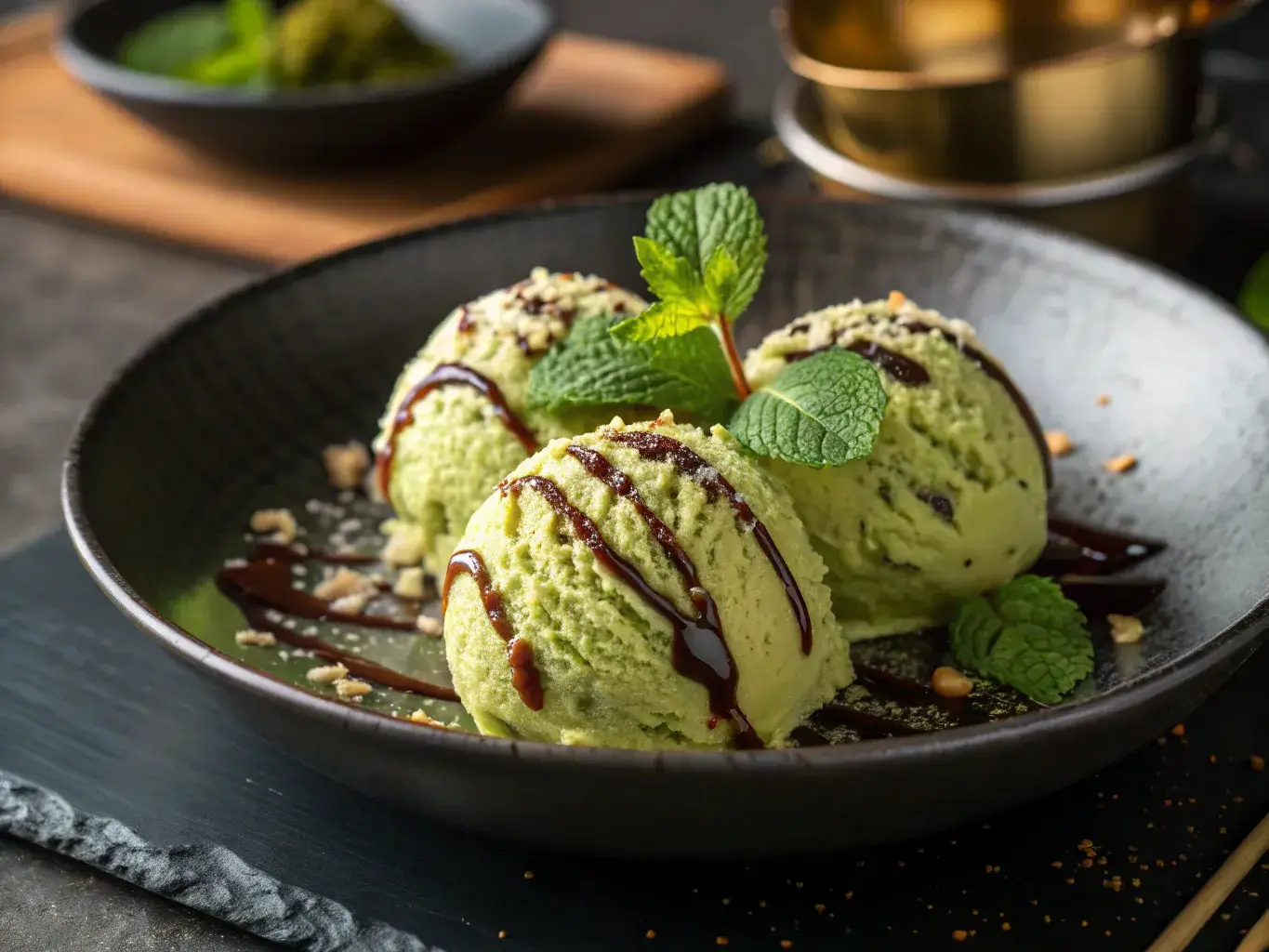Tempura Green Tea Ice Cream is a golden, crispy delight hiding a silky burst of chilled matcha goodness inside. This show-stopping fusion dessert perfectly blends the traditional elegance of Japanese matcha with the crunchy indulgence of tempura frying, creating a treat that’s as visually stunning as it is delicious. Beloved in restaurants, food trucks, and even homemade kitchens, it’s quickly becoming a must-try for dessert lovers everywhere.
In this in-depth guide, we’ll explore everything you need to know about tempura green tea ice cream, its flavor, preparation, health aspects, and how you can recreate it at home. You’ll also discover its place in Japanese cuisine, where to find it in the U.S., and how it compares to green tea mochi ice cream. If you’re after a bold, Instagram-worthy treat that always impresses, this dessert deserves a spot on your list.
What Is Tempura Green Tea Ice Cream?
The Origin and Cultural Fusion of Tempura Ice Cream
While tempura green tea ice cream might sound like something dreamed up in a modern dessert lab, it’s rooted in cultural fusion. The tempura technique, lightly frying foods in batter, originated in Japan centuries ago. Matcha (green tea powder) has long held ceremonial and culinary significance there. Somewhere along the way, a brilliant chef decided to deep-fry a scoop of matcha ice cream, and boom, a culinary trend was born.
Today, this dessert is a staple in Japanese-American eateries, especially in hibachi restaurants and sushi bars. It blends tradition and innovation, crunch and cream, warmth and chill all in one bite.
Print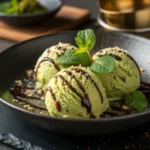
Tempura Green Tea Ice Cream – The Ultimate Crispy & Creamy Dessert Guide
- Total Time: 2 hours 15 minutes
- Yield: 4 servings 1x
- Diet: Vegetarian
Description
A delicious Japanese-inspired dessert featuring scoops of green tea ice cream wrapped in sponge cake, dipped in tempura batter, and quickly deep-fried to golden perfection.
Ingredients
- 4 scoops green tea ice cream
- 4 slices pound cake or sponge cake
- 1 cup all-purpose flour
- 1 tablespoon cornstarch
- 1 teaspoon baking powder
- 1 tablespoon sugar
- 1/4 teaspoon salt
- 1 egg
- 3/4 cup ice-cold water
- Vegetable oil, for deep frying
- Powdered sugar or chocolate sauce, for serving (optional)
Instructions
- 1. Line a baking sheet with parchment paper. Place 4 scoops of green tea ice cream on the sheet and freeze until solid, about 1 hour.
- 2. Wrap each scoop of ice cream with a slice of pound cake, shaping it into a ball. Freeze again for 1 hour or until very firm.
- 3. In a bowl, whisk together the flour, cornstarch, baking powder, sugar, and salt.
- 4. In a separate bowl, lightly beat the egg and mix with the ice-cold water.
- 5. Add the wet ingredients to the dry ingredients and stir just until combined. Do not overmix; the batter should be slightly lumpy.
- 6. Heat vegetable oil in a deep fryer or large saucepan to 375°F (190°C).
- 7. Dip each frozen ice cream ball into the tempura batter, coating it fully.
- 8. Carefully lower each ball into the hot oil and fry for 10–15 seconds, just until golden brown.
- 9. Remove with a slotted spoon and drain on paper towels.
- 10. Serve immediately with powdered sugar or a drizzle of chocolate sauce, if desired.
Notes
- Ensure the ice cream is very firm before frying to prevent melting.
- Use cold water in the batter for a crispier tempura texture.
- Only fry one or two balls at a time to maintain oil temperature.
- Prep Time: 2 hours
- Cook Time: 15 minutes
- Category: Dessert
- Method: Deep Frying
- Cuisine: Japanese
Nutrition
- Serving Size: 1 tempura ice cream ball
- Calories: 320
- Sugar: 18g
- Sodium: 210mg
- Fat: 18g
- Saturated Fat: 9g
- Unsaturated Fat: 7g
- Trans Fat: 0g
- Carbohydrates: 34g
- Fiber: 1g
- Protein: 5g
- Cholesterol: 70mg
Keywords: tempura, green tea, ice cream, fried dessert
Understanding the Popularity of Green Tea as an Ice Cream Flavor
Why green tea? Simply put, it’s bold, earthy, and refreshing. Unlike overly sweet desserts, matcha ice cream offers a slightly bitter, umami-rich flavor that pairs beautifully with tempura’s crisp coating. In fact, tempura green tea ice cream works so well because it contrasts texture and taste in every bite.
Green tea is also associated with mindfulness, antioxidants, and natural energy. So, this dessert doesn’t just taste good, it feels good, too.
How Tempura and Ice Cream Became an Iconic Combo
The genius behind tempura ice cream lies in the temperature play. The ice cream remains frozen inside while the outer tempura batter turns golden and crispy in a flash fry. This creates a memorable mouthfeel that surprises first-timers and delights regulars.
Chefs often use ultra-cold green tea ice cream wrapped in sponge cake or mochi before dipping it into batter. It’s a balance of speed, timing, and freezer science.
Check out Homemade Biscuit Nutrition – The Complete Guide to Healthier Comfort Food for another look at upgrading traditional comfort foods.
What Does Green Tea Ice Cream Taste Like?
Exploring the Distinct Flavor Profile of Matcha
Green tea ice cream, especially when made with high-quality matcha, isn’t your average sweet treat. It brings a bold, earthy flavor that’s slightly bitter, grassy, and even savory at times. This depth is what makes tempura green tea ice cream so irresistible. While vanilla or chocolate ice cream plays it safe, matcha delivers complexity that dances on your tongue.
The flavor isn’t just unique; it’s calming. That comes from L-theanine, a naturally occurring amino acid found in green tea that promotes relaxation. It’s like dessert with a side of Zen.
How Sweetness Balances the Earthy Bitterness
Let’s face it, matcha isn’t everyone’s cup of tea when served pure. But once it’s churned into a creamy, lightly sweetened ice cream base, it transforms. The bitterness softens, the umami pops, and what you get is a rich, velvety scoop that feels both indulgent and refreshing.
The batter-fried crust of tempura green tea ice cream brings a slightly salty, buttery counterpoint to the matcha’s depth. This sweet-savory interplay makes the flavor even more compelling.
Texture Contrast Between Fried Crust and Creamy Center
Now, let’s talk texture. The magic of tempura green tea ice cream lies in its physical contrast. A light, golden crust gives way to an icy-cold, creamy center. The first bite crunches. The second melts. The third makes you wonder why all ice cream isn’t served this way.
This duality, crunchy outside, creamy inside, isn’t just fun, it’s addictive. No wonder foodies and chefs alike keep reinventing this iconic Japanese dessert.
Looking for inspiration? Try Nutrition Facts for Biscuits and Gravy – The Best 2025 Health Breakdown to balance indulgent eats with smart choices.
Is Tempura Green Tea Ice Cream Healthy?
Nutritional Breakdown of Green Tea Ice Cream
Here’s the deal: green tea is packed with antioxidants, particularly catechins, which are known for supporting heart health and metabolism. In its pure form, matcha is a superfood. But once it’s turned into ice cream and then deep-fried, things shift.
A single serving of tempura green tea ice cream can contain anywhere from 250 to 450 calories, depending on portion size and ingredients. Most of the fat comes from cream and frying oil, while sugar adds to the carb count.
Still, compared to other fried desserts, it’s relatively moderate, especially if you make it with low-fat dairy or plant-based alternatives.
How Frying Affects Calorie Content
Frying naturally increases the caloric content. But because tempura green tea ice cream is flash-fried at high heat for just a few seconds, it absorbs less oil than you’d expect. The batter is also lighter than typical American fry coatings.
Want to make a healthier version? Air-frying or baking the crust with panko or rice flour can reduce oil while keeping that satisfying crunch. You can also swap out cream for coconut milk or oat milk to reduce saturated fats.
Health Benefits of Matcha vs. Indulgent Dessert Aspects
So, is it healthy? Let’s call it a treat with benefits. You’re getting antioxidant-rich matcha in every bite, along with a dose of dopamine-boosting indulgence. When enjoyed in moderation, tempura green tea ice cream can fit into a balanced lifestyle.
For those watching sugar, homemade versions let you control sweeteners. And if you’re looking for gluten-free or dairy-free versions,
How Is Tempura Ice Cream Made?
Step-by-Step Process of Battering and Frying
Making tempura green tea ice cream sounds like a culinary trick, but it’s totally doable if you follow the right steps. The key lies in prep and speed. Here’s the basic flow:
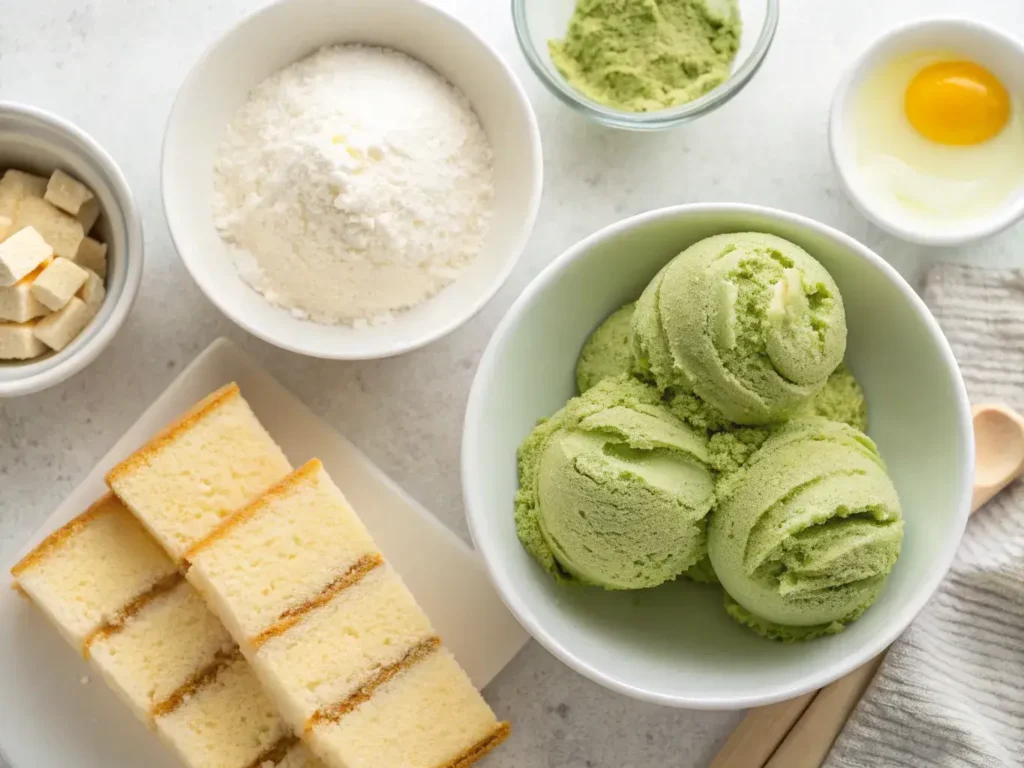
- Scoop the green tea ice cream into firm balls (about 2–3 inches in diameter).
- Place them on a tray lined with parchment paper and freeze solid for at least 2–4 hours (overnight is better).
- Wrap each scoop in thin slices of pound cake or sponge cake. This layer protects the ice cream during frying.
- Refreeze the wrapped scoops until rock-solid.
- Dip each frozen ball into tempura batter (a light mix of flour, egg, and ice-cold water).
- Immediately deep fry at 400°F (204°C) for 15–20 seconds, just until golden.
You’ve got to be fast and efficient this dessert doesn’t wait. The trick is keeping the ice cream frozen while the batter crisps up in the fryer. Too long, and you’ll end up with a melted mess.
Best Practices for Freezing Before Frying
Here’s the secret sauce: ultra-low temperatures. The colder your green tea ice cream is, the better it holds up during frying. A good hack? Use dry ice or a deep freezer if you have access. You can also double-wrap the scoops in plastic wrap after forming to avoid freezer burn.
It’s also important that the cake layer is not too thick just enough to shield the ice cream but thin enough to let the batter crisp evenly.
Let the batter rest for 10 minutes before using. This helps activate the gluten just enough to bind, but not too much to become chewy.
Common Mistakes to Avoid During Preparation
Even seasoned chefs mess up tempura green tea ice cream the first time. Here’s what not to do:
- ❌ Don’t fry room-temp scoops you’ll get ice cream soup.
- ❌ Avoid thick or dry cake wrappers, which won’t meld with the batter.
- ❌ Don’t overcrowd the fryer, or oil temperature will drop, leaving you with soggy crusts.
- ❌ Don’t skip re-freezing after wrapping this step is key to preserving structure.
Keep your oil hot, your prep cold, and your timing tight, and you’ll nail it every time.
Can You Make Tempura Green Tea Ice Cream at Home?
Ingredients and Tools You’ll Need
Yes, you can absolutely make tempura green tea ice cream at home, even without a restaurant-grade fryer. With just a few tools and some patience, this show-stopping dessert is DIY-friendly.
Here’s what you’ll need:
Ingredients:
| Ingredient | Quantity |
|---|---|
| Green tea (matcha) ice cream | 1 pint (or 4–6 scoops) |
| Pound cake or sponge cake | Thin slices (1 per scoop) |
| All-purpose flour | 1 cup |
| Egg | 1 |
| Ice-cold water | ¾ cup |
| Baking powder (optional for fluffiness) | ½ tsp |
| Oil for frying (vegetable or canola) | Enough for deep frying |
| Optional toppings | Red bean paste, mochi, chocolate drizzle |
Tools:
- Ice cream scoop
- Parchment paper
- Plastic wrap
- Deep fryer or heavy-bottomed pot
- Tongs or slotted spoon
- Thermometer (a must!)
Prep everything before you start frying. Timing is everything in this dish.
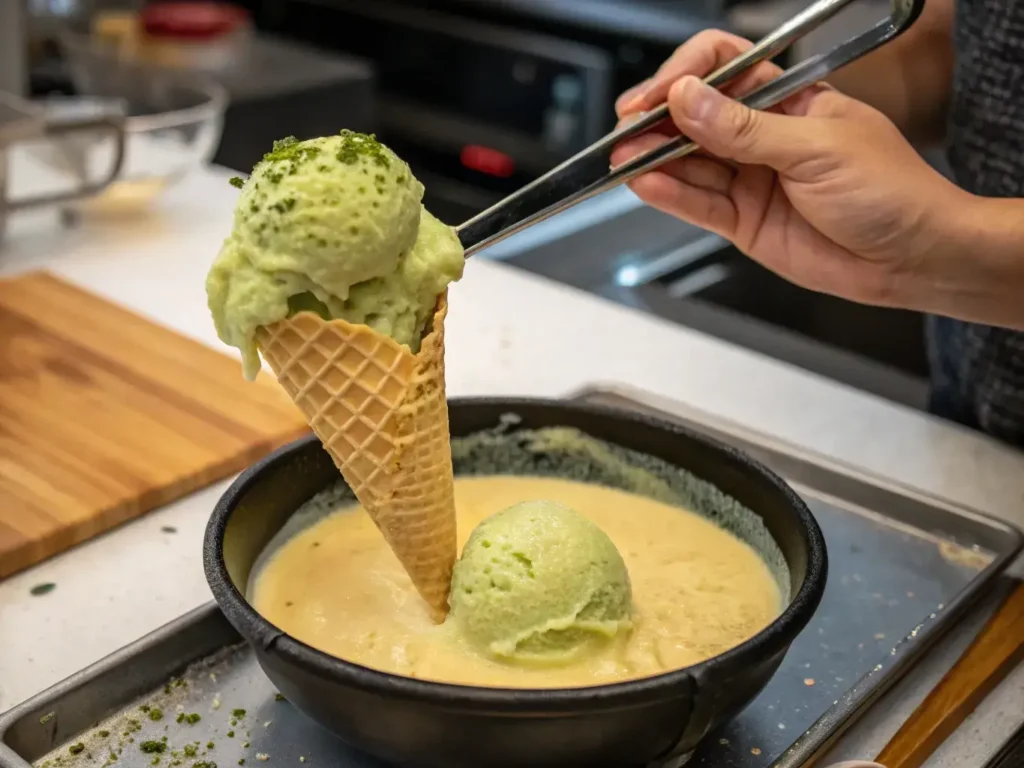
Homemade Recipe Instructions
Let’s break down the homemade process for tempura green tea ice cream in simple steps:
- Scoop and Freeze
Scoop the green tea ice cream into firm balls. Place them on a tray and freeze until rock-hard (overnight is ideal). - Wrap in Cake
Cut sponge cake into thin slices. Wrap each scoop tightly and refreeze for at least 2 more hours. - Make the Batter
In a bowl, whisk together flour, egg, and ice-cold water. You can also mix in a touch of baking powder for added fluff. - Heat the Oil
Heat oil in your pot to 400°F. The oil must be hot enough to flash-fry, not soak. - Dip and Fry
Dip one ice cream ball into batter, fully coating it. Fry immediately for 15–20 seconds until golden. Remove with tongs and place on paper towels. - Serve Immediately
Slice gently to show the green center. Serve with toppings if desired.
Gluten-Free and Dairy-Free Variations
The beauty of this recipe? It’s flexible. Here’s how to switch it up for different dietary needs:
Gluten-Free Option:
- Use gluten-free sponge cake or rice flour pancakes for wrapping.
- Swap all-purpose flour with rice flour or a gluten-free blend in the batter.
Dairy-Free Option:
- Choose a dairy-free matcha ice cream made with almond, oat, or coconut milk.
- Make the batter using egg replacer or aquafaba, and check that your flour is dairy-free.
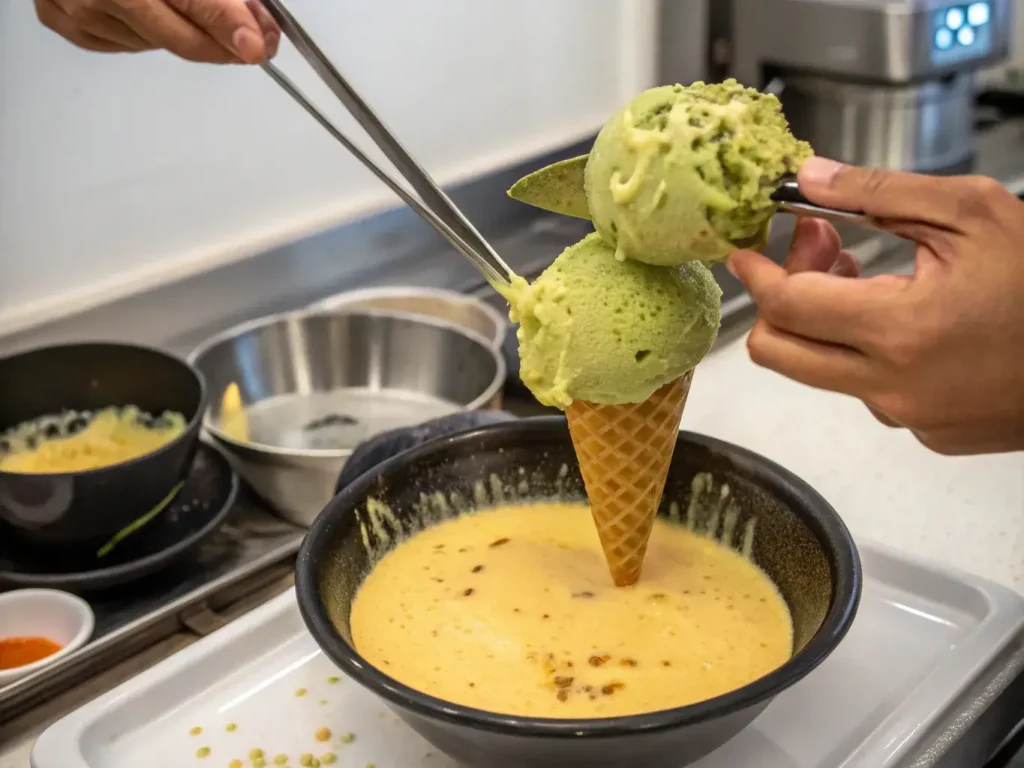
These swaps don’t just make it inclusive they add interesting new textures and flavors. Coconut milk-based ice cream, for example, adds richness that pairs beautifully with fried batter.
Tempura Ice Cream in Japanese Cuisine
How Tempura Desserts Evolved in Japan
In Japan, tempura is typically a savory dish, think shrimp, vegetables, or seafood, all lightly battered and flash-fried. But over time, tempura green tea ice cream emerged as a modern twist, blending traditional Japanese elements with Western indulgence.
This dessert likely gained traction in Japanese-American fusion restaurants before making its way back into contemporary menus in Japan. While not a historical staple, it’s now celebrated as a bold reimagining of the country’s deep culinary roots one that’s just as visually stunning as it is delicious.
Tempura desserts started appearing more frequently in Japan’s izakaya pubs and upscale restaurants, particularly those with an omakase (chef’s choice) concept. From fried sweet potato and bananas to matcha tempura ice cream, the trend continues to evolve.
Why Green Tea Is the Preferred Flavor
In Japanese cuisine, matcha isn’t just a trend; it’s a tradition. Used in tea ceremonies for centuries, it embodies mindfulness and purity. That’s why green tea became the go-to flavor for this dessert.
Tempura green tea ice cream captures the balance Japanese cuisine is famous for: harmony between flavor, texture, and temperature. It’s not overly sweet like many Western desserts. Instead, it lets the umami richness of matcha and the crisp bite of tempura take center stage.
Other flavors like red bean or black sesame sometimes make an appearance, but none have quite the same reputation or balance as the classic matcha version.
Modern Interpretations in Japanese-American Fusion Restaurants
Today, tempura green tea ice cream is a popular fixture at sushi bars, teppanyaki grills, and hibachi-style restaurants in the U.S. Chefs often get creative adding crushed pistachios, mochi crumbles, or chocolate drizzle for flair.
Some menus even feature “ice cream tempura towers” or sampler plates that include other flavors like vanilla, mango, or red bean. But matcha remains the star.
This modern fusion isn’t about breaking tradition, it’s about enhancing it with bold presentation and multicultural flair.
Green Tea Mochi Ice Cream vs. Tempura Green Tea Ice Cream
Main Differences in Ingredients and Texture
While both desserts showcase the beloved matcha flavor, green tea mochi ice cream and tempura green tea ice cream couldn’t be more different in execution.
| Feature | Tempura Green Tea Ice Cream | Green Tea Mochi Ice Cream |
|---|---|---|
| Outer Layer | Fried tempura batter | Chewy mochi rice dough |
| Texture | Crunchy + creamy | Chewy + cold |
| Cooking Method | Deep-fried | Frozen, no cooking |
| Calories | Higher due to frying | Typically lower |
| Shelf Life | Short (serve immediately) | Long (store-bought or homemade frozen) |
Green tea mochi ice cream uses a stretchy, sticky outer shell made from glutinous rice flour, giving it a smooth chew. In contrast, tempura green tea ice cream is all about that hot-cold, crisp-soft explosion.

Which Is Healthier and Why?
From a nutritional standpoint, green tea mochi ice cream tends to be lighter. It skips the frying and often comes in smaller, portion-controlled servings. It’s also lower in fat and calories, especially if store-bought versions use skim or non-dairy bases.
That said, tempura green tea ice cream offers a richer, more indulgent experience. If you’re watching calories or fats, opt for mochi. But if you’re celebrating or treating yourself, the tempura version is worth every bite.
Serving Suggestions and Cultural Significance
Both desserts can be elevated with creative plating. Mochi ice cream pairs well with sliced fruits, whipped cream, or sesame seeds. Meanwhile, tempura green tea ice cream shines with red bean paste, chocolate syrup, or even edible gold leaf.
In terms of cultural significance, mochi is more traditional. It’s used in New Year’s dishes and ceremonial sweets. Tempura green tea ice cream, on the other hand, symbolizes Japan’s ever-evolving food culture where tradition meets trend.
Where to Buy Tempura Green Tea Ice Cream
Popular Restaurants and Dessert Bars That Serve It
If you’re craving tempura green tea ice cream but don’t feel like frying it yourself, don’t worry, this dessert has found its way onto menus nationwide. You’ll commonly find it at:
- Japanese hibachi steakhouses
- Teppanyaki-style grills
- Asian fusion dessert cafés
- Sushi bars in major cities like Los Angeles, New York, and Chicago
These spots usually serve it as a surprise finale, a piping hot shell hiding chilled matcha treasure. Presentation often includes chocolate drizzle or powdered sugar for flair.
Look for restaurants like Benihana, RA Sushi, or local mom-and-pop ramen spots that offer authentic dessert menus.
Availability at Grocery Stores and Asian Markets
While fresh-fried versions are rare at supermarkets, many Asian grocery stores carry frozen varieties of tempura green tea ice cream or similar matcha-based desserts. Here are your best bets:
| Store | What You Might Find |
|---|---|
| H Mart | Frozen matcha desserts, mochi ice cream |
| Mitsuwa | Japanese specialty desserts, tempura-style ice cream kits |
| 99 Ranch Market | Green tea flavored mochi or pre-rolled ice cream balls |
Just check the frozen dessert section or ask a store clerk. Some even stock ready-to-fry matcha ice cream balls that you can crisp up at home.
Does Trader Joe’s Sell Green Tea Ice Cream?
Trader Joe’s has become a cult-favorite for unique frozen desserts, and yes they have sold green tea ice cream in the past. While it’s not always in stock, keep an eye on their seasonal dessert section.

What’s more common now is green tea mochi ice cream, which Trader Joe’s frequently rotates in and out of their freezer aisle. If you don’t find the exact matcha tempura ice cream, try combining their matcha ice cream with your own tempura batter recipe.
It’s not quite the same, but it’s pretty close and incredibly satisfying.
Creative Ways to Serve Tempura Green Tea Ice Cream
Plating Ideas for Aesthetic Appeal
Want your tempura green tea ice cream to look as good as it tastes? Presentation matters especially if you’re serving guests or snapping pics for social. Try:
- Serving on slate or black plates for contrast
- Adding a matcha powder dusting over the top
- Garnishing with fresh mint, berries, or edible flowers
- Drizzling with honey, condensed milk, or dark chocolate sauce
Use a serrated knife to cleanly slice through the crust and show off that green core.
Pairing with Sauces and Toppings
To take your dessert to the next level, consider some classic pairings:
| Topping | Flavor Effect |
|---|---|
| Sweet red bean paste | Adds traditional Japanese depth |
| Black sesame seeds | Offers crunch and nuttiness |
| Mochi bits | Creates textural harmony |
| Coconut flakes | Brings tropical flair |
| Crushed pistachios | Elevates with salty richness |
Each of these pairs beautifully with the slightly bitter, creamy center of tempura green tea ice cream.
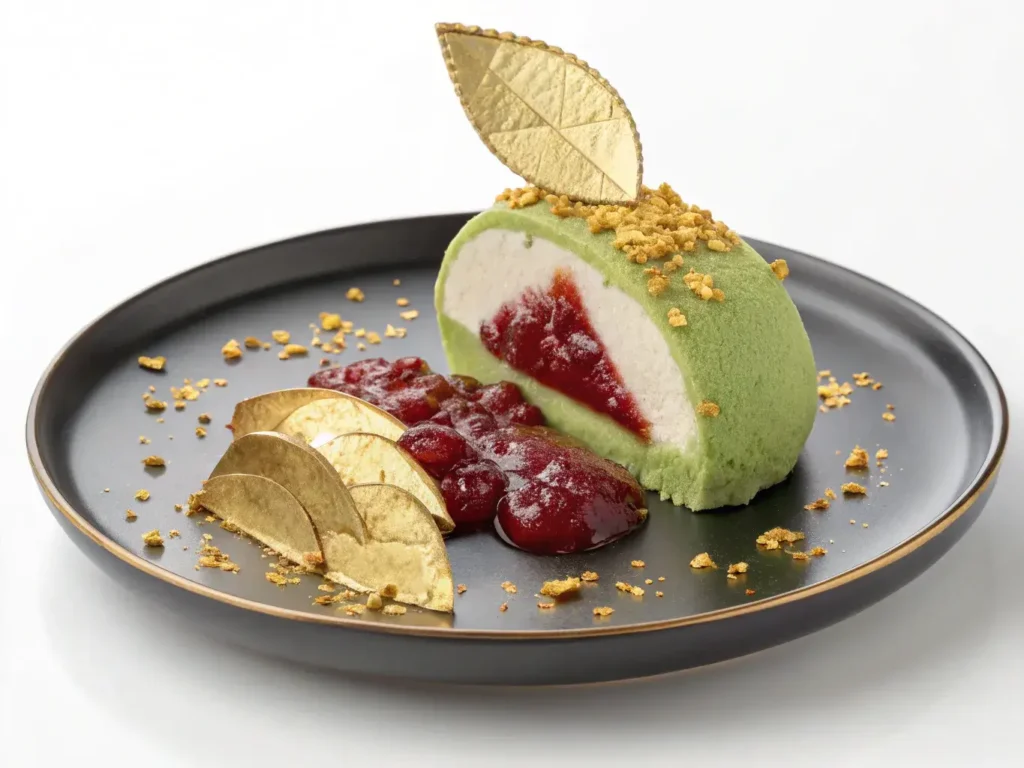
How to Wow Guests at a Dinner Party or Food Event
Hosting a party? This dessert is the ultimate mic drop. Here’s how to impress:
- Prep the scoops in advance and freeze overnight
- Fry them fresh as guests watch
- Serve with sake or a matcha cocktail
- Add a mini bamboo skewer or golden spoon for presentation
It’s a conversation-starter that looks gourmet but feels cozy. Whether it’s plated traditionally or served in a paper cone at a food stall, tempura green tea ice cream always steals the show.
Frequently Asked Questions About Tempura Green Tea Ice Cream
What flavor is green tea ice cream?
Green tea ice cream has an earthy, umami-rich taste with slight bitterness and natural sweetness. It’s made with matcha, a fine green tea powder, giving it a bold yet refreshing flavor profile that balances creamy and crisp textures when served as tempura green tea ice cream.
Is green tea mochi ice cream healthy?
Green tea mochi ice cream is generally lighter than tempura versions, with fewer calories and no frying. It still contains sugar and dairy but offers a portion-controlled, gluten-free option rich in antioxidants from the matcha.
How is tempura ice cream made?
Tempura ice cream is made by wrapping frozen scoops of ice cream (often green tea) in cake or mochi, dipping them in light tempura batter, and flash-frying for a few seconds until golden. The result is a hot-crispy outside and cold-creamy inside.
Does Trader Joe’s sell green tea ice cream?
Yes, Trader Joe’s has sold green tea ice cream in the past and often stocks green tea mochi ice cream. Check their frozen dessert section for availability or seasonal options.

